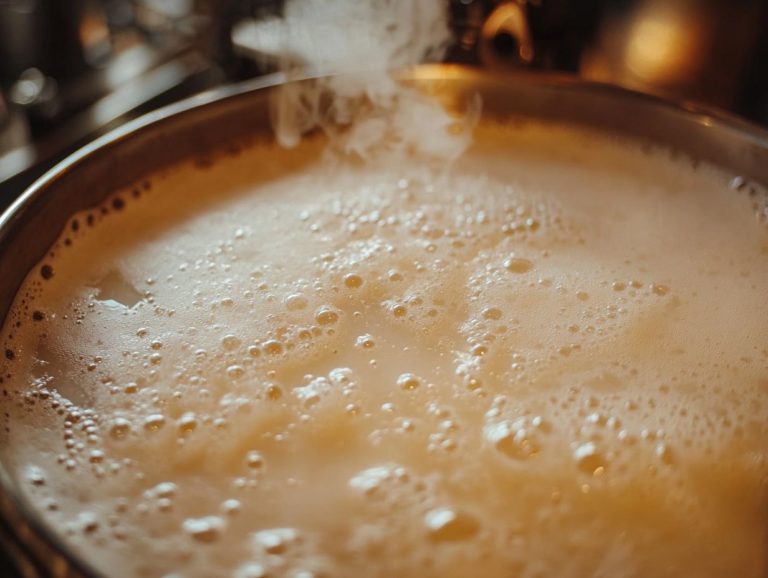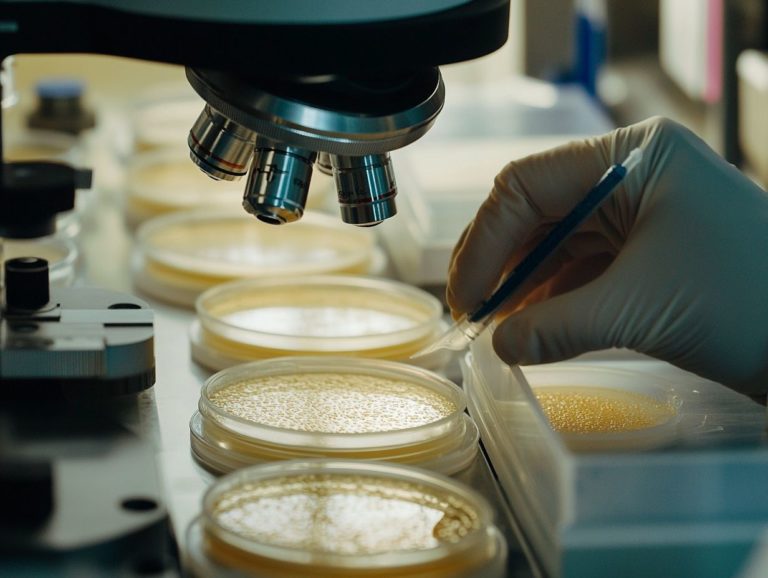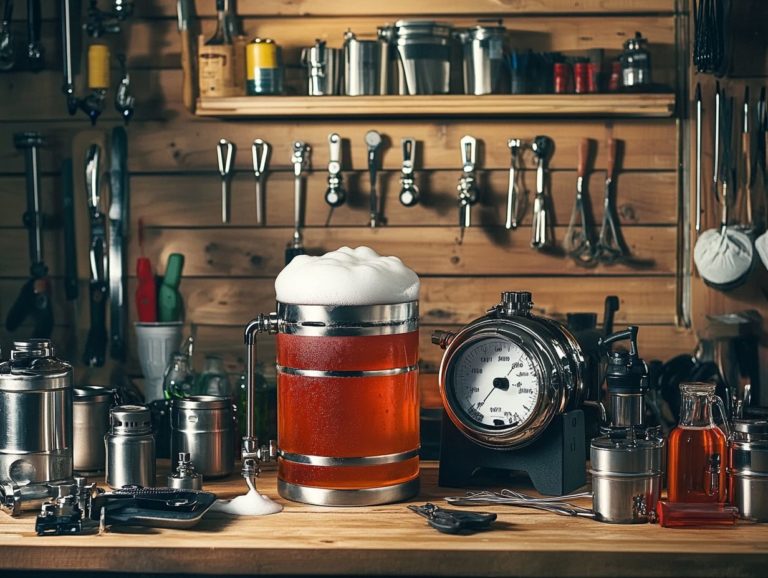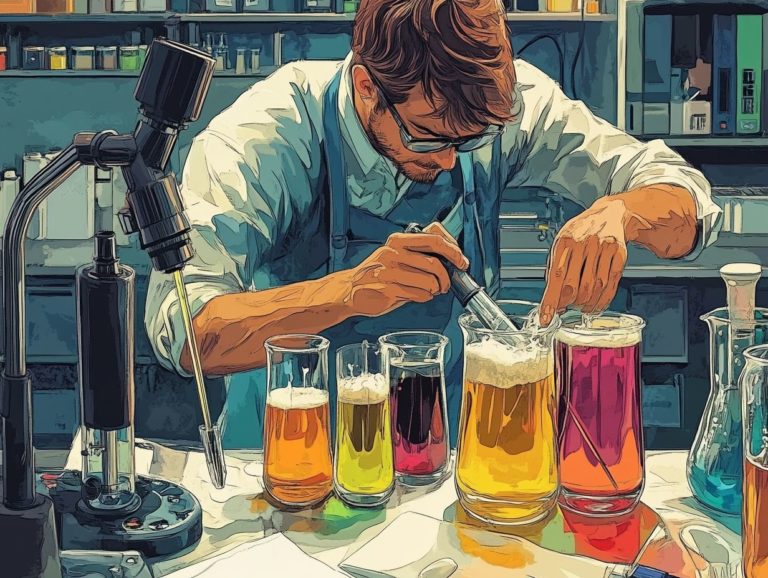Addressing Hazy Beer: Causes and Solutions
Contents
- The Allure of Hazy Beer: Understanding Causes and Solutions
- Understanding Hazy Beer
The Allure of Hazy Beer: Understanding Causes and Solutions
Hazy beer has captivated the curiosity of countless craft beer enthusiasts, igniting spirited debates about its allure and quality. It raises questions about brewing techniques and the fining agents involved.
But what exactly contributes to that cloudiness? Factors such as yeast, protein, hops, and starch all play a significant role in the final product, often resulting in phenomena like chill haze, protein haze, and cloudiness caused by yeast.
This article delves into the reasons behind hazy beer. It examines why some might perceive it as unappealing and offers effective brewing techniques such as proper filtering and usage of fining agents to prevent or rectify the issue.
Whether you re an aspiring homebrewer or simply someone who prefers a clear pint, grasping these elements including managing yeast health and understanding yeast strains can elevate your brewing experience to new heights.
Key Takeaways:
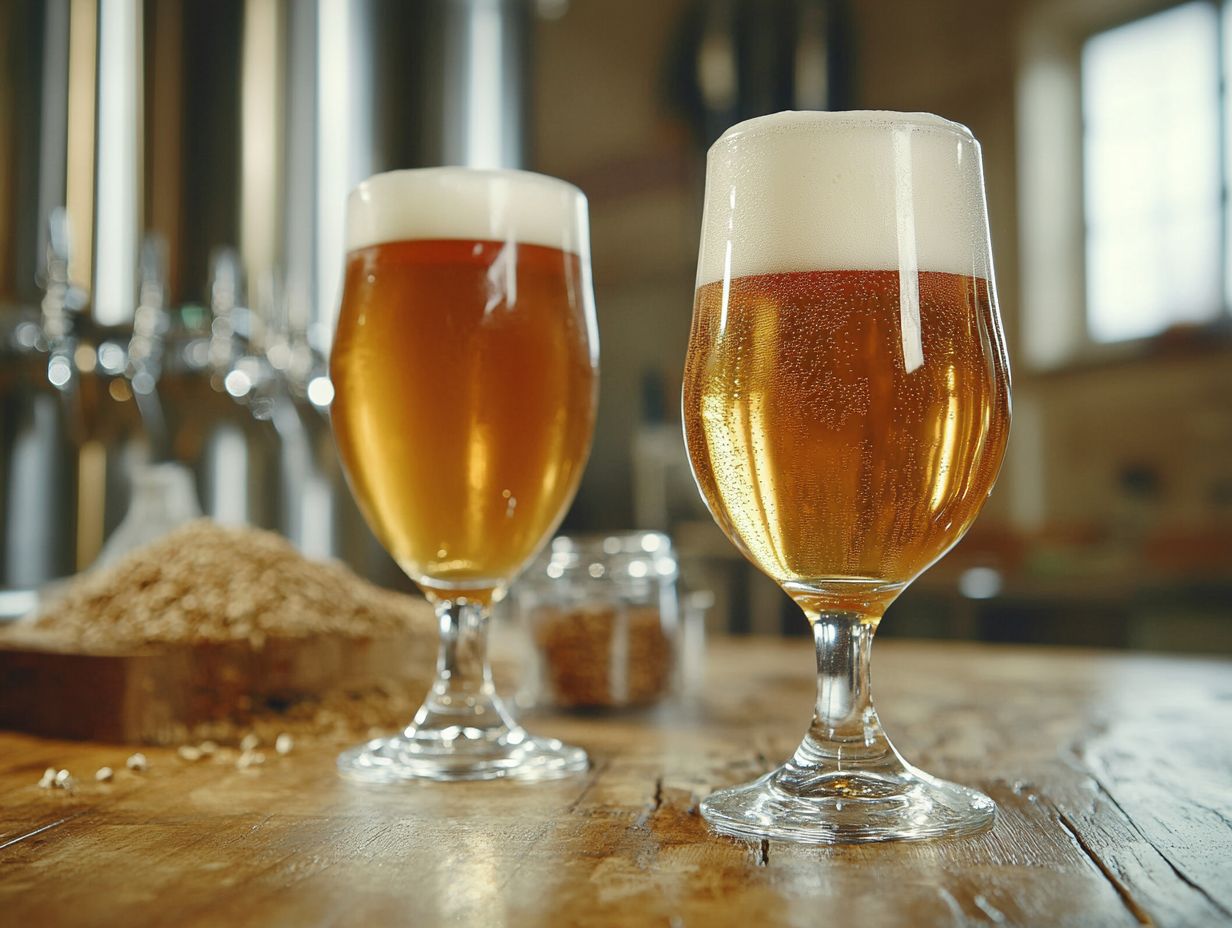
- Brewing techniques play a key role in producing clear beer. Proper temperature control and timing during fermentation can prevent hazy beer caused by yeast, protein, and starch.
- Clarifying agents, filtering, and cold crashing are effective methods to prevent hazy beer. These processes help remove particles and sediment from the beer, resulting in a clearer appearance and improved beer clarity.
- If you encounter hazy beer, there are various options to fix it, such as giving it time to settle, using gelatin finings, reboiling, adding enzymes, or diluting it. However, prevention is key to avoid hazy beer in the future.
What Causes Hazy Beer?
Hazy beer, a rising favorite among craft beer aficionados, can emerge from a variety of phenomena during the brewing process, such as chill haze, protein haze, and cloudiness caused by yeast. The presence of natural compounds found in plants that can affect beer clarity and other precipitates created during fermentation plays a significant role in haze formation as well.
Understanding these causes is crucial for crafting exceptional brews. It involves understanding the science behind hop oils and yeast growth dynamics.
Yeast plays a crucial role in your brewing journey, not only in fermentation but also as a key player in haze formation, primarily through cloudiness caused by yeast and issues related to yeast health and free oxygen.
The health and growth of your chosen yeast strains during fermentation can significantly impact the clarity of your final beer. If you re working with poorly flocculating yeast, you may encounter frustrating haze stability issues.
Different yeast strains whether ale, lager, or wild yeasts show varying flocculation characteristics, which directly influence the turbidity levels and haze stability in your brew.
For example, certain ale yeasts may settle out more readily than lagers, helping to reduce haze formation. The brewing techniques you employ, including temperature management and the addition of fining agents, can also enhance yeast performance.
By ensuring optimal yeast health through appropriate pitching rates and nutrient availability, you contribute to a cleaner fermentation process. Ultimately, all these factors weave together within the intricate tapestry of brewing science, where achieving clarity stands as a hallmark of quality in your final product.
Experiment with your brewing techniques and share your results to create the best brews possible!
2. Protein
Protein haze occurs when the proteins in your beer interact with polyphenols, resulting in that pesky haze that can diminish its clarity. You can effectively mitigate this interaction by employing fining agents, which are substances used to clear beer, such as Irish moss and Whirlfloc. These agents promote the bonding of protein and polyphenol, aiding in the clarification process during brewing.
The science behind these interactions lies in the chemistry of your brewing ingredients, involving polyphenols, proteins, and hop oils. Proteins, derived from malt, can bind with polyphenols found in hops and grains, forming complexes that manifest as haze. By incorporating fining agents like Irish moss and Whirlfloc, you streamline this process. These agents contain carrageenan, which binds to excess proteins and polyphenols, facilitating their aggregation and eventual settling out of the beer.
As a result, you not only improve the visual appeal by reducing haze but also create a smoother flavor profile. This allows the desired aromas and tastes to shine through more distinctly. Ultimately, understanding and managing these interactions is crucial for crafting a beer with exceptional sensory qualities.
3. Starch
Starch haze emerges from unconverted starches lingering in your beer after the brewing process, primarily a result of incomplete mashing or insufficient enzyme activity. This haze can be further complicated by oxidation haze, where oxidized compounds interact with those residual starches, impacting the clarity and visual appeal of your brew.
The importance of starch conversion during the mashing process cannot be understated; it directly influences the overall quality and drinkability of your final product, particularly in reducing starch haze. When you re brewing, achieving the best enzyme activity is essential. If your mashing techniques fall short, unwanted haze can ruin your beer’s appeal.
Oxidation haze also poses challenges, as oxygen interacts with various compounds, affecting your beer’s stability and longevity. Maintaining proper oxygen levels is crucial.
To combat these issues, focus on fine-tuning your mashing temperatures, ensuring sufficient enzyme activation, and employing effective oxygen management strategies throughout the brewing journey. Act quickly to ensure enzyme activity to avoid stubborn haze!
By implementing these preventive measures, you can significantly enhance both the clarity and overall quality of your beer.
4. Hops
Hops play a crucial role in not only enhancing the aroma and flavor of your beer but also in contributing to its haze, thanks to the hop oils and their interactions with polyphenols. When you employ dry-hopping techniques, you can elevate the hop character, but be mindful that this process may inadvertently boost haze stability due to the polyphenolic compounds released, resulting in a cloudier final product.
The complex relationship between various hop varieties and their distinct oil compositions is key to understanding this haze factor. Each hop variety offers its own unique profile; some deliver high levels of aromatic oils, while others are more about the polyphenols. When you dry-hop, you re tapping into these compounds to enhance your beer’s sensory characteristics. However, you ll need to navigate the potential for increased haze formation. Striking the right balance is crucial because certain hop oils can engage with polyphenols to produce a delightful flavor profile while also affecting the beer s clarity.
Therefore, by thoughtfully selecting hop varieties, such as pellet hops, and meticulously applying dry-hopping techniques, you can achieve the perfect harmony of hop character and clarity in your brew.
Why Is Hazy Beer Unappealing?
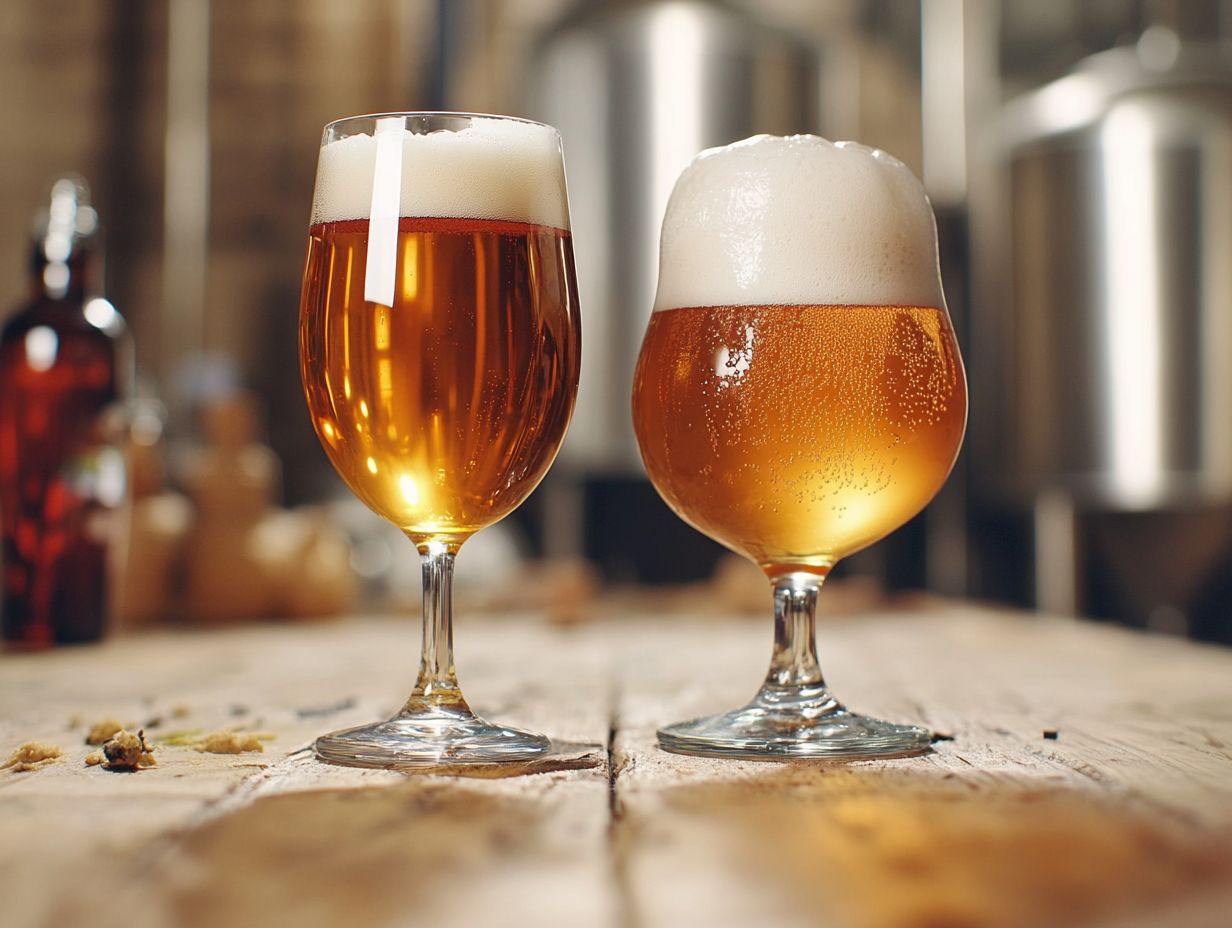
Some commercial brewers believe that hazy beer may indicate brewing flaws.
While a certain haze in beer can be an intentional stylistic choice think New England IPAs or Belgian-style beers like hefeweizen and Witbier too much haze might give consumers pause. This undermines their overall drinking experience and the beer’s clarity.
This reaction often stems from associations with subpar brewing techniques or sanitation concerns, clouding the perception of the final product.
Your preference for clear beer is likely intertwined with the prevailing beliefs among many drinkers about quality and the avoidance of brewing flaws. A clear brew is often linked to careful brewing methods and a high level of craftsmanship.
This reinforces the idea that clarity signifies purity and attention to detail.
To win over your consumers, make it a priority to achieve a crystal-clear finish in your production. It communicates professionalism and instills confidence in consumers regarding the integrity of your beverage.
Even a hint of haziness can provoke hesitation, prompting you to prioritize clarity in your production processes. This approach not only aligns with consumer expectations but also bolsters your brand reputation.
How to Prevent Hazy Beer?
Stop hazy beer in its tracks by using a blend of effective brewing techniques, utilizing clarification methods, and selecting the right fining agents. All of these efforts aim at achieving the clarity standards you desire in your final product.
As a commercial brewer, consider implementing practices such as careful yeast management, choosing the right grains, and integrating filtering systems to significantly reduce haze formation.
1. Proper Brewing Techniques
Proper brewing techniques are vital for preventing hazy beer. This starts with the health of the yeast used for fermentation.
This includes managing yeast nutrients and monitoring yeast growth. The right yeast can significantly impact the clarity of your brew.
Pay close attention to your water profile and the nutrition you provide to the yeast; these factors can enhance yeast clumping and overall performance, leading to a clearer final product.
If clarity is your goal, understanding the balance of minerals in your water is essential, as it directly influences yeast activity and fermentation outcomes.
Incorporating yeast nutrients, like diammonium phosphate, can bolster yeast health by preventing deficiencies that might impede fermentation.
This proactive approach fosters robust yeast growth and encourages effective flocculation, where yeast cells clump together and settle at the bottom of your fermentation vessel.
The interplay of these elements is crucial; a well-flocculated yeast population means less suspended particulate matter, ultimately resulting in a more visually appealing beer with enhanced clarity.
This is especially true in Belgian-style beers where clarity is often a key quality indicator.
2. Clarifying Agents
Utilizing clarifying agents like Irish moss and Whirlfloc is your proactive strategy for preventing haze formation in beer. These substances that clear the beer excel at promoting the precipitation of proteins and polyphenols, resulting in a clearer brew that aligns perfectly with consumer expectations for clarity.
Proper use of these agents is crucial in brew techniques practiced by breweries such as Allagash and Labatt. The magic of these agents lies in their unique mechanisms. Irish moss, a type of seaweed, releases carrageenan that binds with unwanted particles, while Whirlfloc brings similar properties along with added brewing advantages. These agents are essential for preventing chill haze and starch haze, both common issues in beer clarity.
Incorporating these clarifiers into your brewing process is best done during the kettle boil phase: add Irish moss about 15-20 minutes before the end of the boil, and introduce Whirlfloc in the final 5 minutes. Ensuring accurate timing and temperature during the brewing process can significantly improve the effectiveness of clarifiers.
To achieve optimal results, it s essential to maintain proper temperature and timing, ensuring the desired flavor profile is preserved while creating a visually appealing brew. For those looking to elevate their craft, experimenting with pH adjustments can enhance the efficacy of these clarifiers, striking a perfect balance between clarity and taste. Incorporating yeast nutrients during the process can also offer substantial benefits.
3. Filtering
Filtering stands out as one of the most effective techniques you can employ to ensure your beer boasts remarkable clarity and prevents any unwelcome haze. By utilizing a suitable filtration system, you can successfully eliminate suspended particles that contribute to cloudiness while preserving the beer’s flavor and aroma characteristics. This is particularly important for styles like New England IPAs, which balance haziness and clarity.
Among the various filtering techniques available, mechanical filtration is a popular choice. This method utilizes fine mesh screens or membranes to capture particulates and is lauded for its ability to produce clear beer without significantly altering the flavor profile.
Alternatively, cross-flow filtration presents a more sophisticated approach. It employs a tangential flow that reduces clogging and enhances efficiency. While this technique often results in exceptional clarity and maintains essential flavor compounds, be mindful of potential drawbacks. Over-filtering can strip away delicate aromas and flavors, making it crucial to find the right balance between achieving visual appeal and preserving the beer’s original character. Knowledge of brewing science can be beneficial here to make informed decisions.
4. Cold Crashing
Cold crashing is a technique you can utilize to lower the temperature of your beer post-fermentation. This promotes yeast flocculation, which is how yeast clumps together, and encourages particulate matter to settle at the bottom of the fermentation vessel. Not only does this process enhance the clarity of your beer, but it also contributes to a cleaner, more refined flavor profile by reducing undesirable compounds. Afterward, packaging the beer carefully can help maintain these qualities.
By implementing cold crashing, you ll be amazed at how much better your beer looks and tastes! When you lower the temperature, yeast and other particles become denser, allowing them to clump together and fall out of suspension more effectively. To optimize your results, aim for a gradual decrease in temperature ideally down to around 32 F (0 C) over a span of 24 to 48 hours. This gradual approach is key to minimizing thermal shock to the yeast.
Ensure good insulation and maintain control over the environment during this phase to further enhance clarity and flavor, ultimately leading to a more enjoyable brewing experience.
How to Fix Hazy Beer?
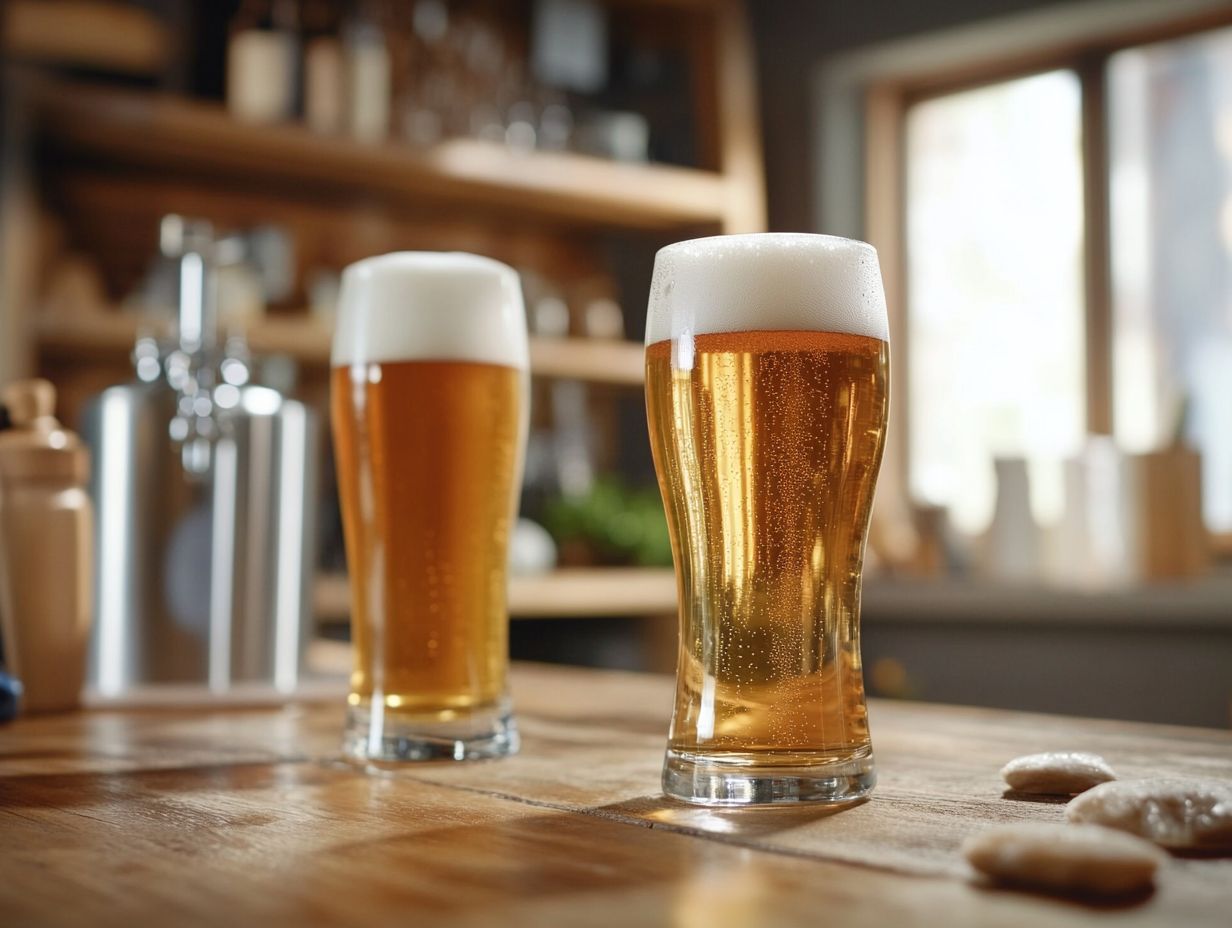
Addressing hazy beer often demands both patience and precise corrective actions, such as employing gelatin finings to clarify the brew after fermentation. This is crucial in styles like Witbier and Hefeweizen, where clarity can be a defining characteristic.
Act fast! Consider other strategies, like reboiling the beer or introducing specific enzymes, which can effectively diminish haze.
In cases where the haze proves particularly stubborn, dilution may be your final option to rescue the batch.
Enhancing Beer Clarity
1. Time
Allowing time for your beer to condition can be a brilliant strategy for reducing haze. It provides the perfect opportunity for particulates to settle down naturally, enhancing overall clarity. This method leans on the natural processes of sedimentation and yeast clumping together, which can significantly elevate the visual allure of your brew over time.
Some brewers, like those producing Allagash White, rely on this technique to achieve their signature clarity. You understand that time is a crucial element in this journey. It allows yeast cells to clump together and drop out of suspension, resulting in clearer beers.
Creating a controlled environment characterized by stable temperatures and minimal agitation can further foster proper settling down.
However, balancing this necessary time with your production schedule is essential. You need to be mindful of market demand while ensuring your beverage reaches its optimal clarity and stability.
By embracing patience in your brewing cycle, you not only enhance the visual appeal of your products but also contribute to a superior overall drinking experience.
2. Gelatin Finings
Using gelatin finings is a popular method for you to enhance beer clarity and minimize haze. It works by binding to suspended particles and facilitating their sedimentation during conditioning. This technique clears up your beer and elevates its mouthfeel, resulting in a more enjoyable drinking experience.
Products from suppliers like Wyeast and White Labs are often used for this purpose. The effectiveness of gelatin in your brewing process lies in its gel-forming properties. It attracts and encapsulates the proteins and yeast cells that contribute to unwanted haze.
It s often recommended that you add the gelatin solution after fermentation but before kegging. Make sure to adhere to specific dosage guidelines for the best results.
While gelatin can greatly improve clarity, you should be aware of potential trade-offs. Some may detect a subtle shift in the flavor profile or mouthfeel since the fining agent can interact with the delicate compounds in your beer. It s wise to conduct small test batches to find the ideal approach for each unique brew you create.
3. Reboiling
Reboiling is a technique you will encounter in the brewing world, aimed at tackling those pesky haze issues. It involves bringing the beer back to a boil to precipitate out haze-forming compounds. While this method can indeed be effective, it demands careful management to ensure the beer’s flavor profile remains intact.
This technique is sometimes employed when other methods like using specific enzymes or centrifugation have not achieved the desired clarity. Brewing professionals often turn to reboiling as a last resort when other haze-reduction strategies, such as fining agents or centrifugation, fall short.
This process effectively denatures the proteins and other compounds responsible for haze, allowing them to coagulate and settle out. However, caution is key; a second boil can lead to the caramelization of sugars and shifts in hop character, which may jeopardize the beer’s intended taste.
If you re contemplating reboiling, it’s wise to meticulously monitor both temperature and time. This way, you can enhance clarity without sacrificing the delicate balance of flavors that truly define your brew.
4. Adding Enzymes
Incorporating enzymes into your brewing process offers a scientifically grounded method for reducing haze. By breaking down haze-forming compounds, you can enhance the clarity of your final product. Enzymatic treatments allow you to target specific sources of haze, giving you greater control over the appearance of your beer.
This method is particularly effective for preventing oxidation haze, which can impact the final quality of your brew. You ll find several types of enzymes particularly effective in this endeavor.
Proteases, for example, specifically tackle the proteins that contribute to haze, while glucanases focus on beta-glucans present in certain grains. These enzymes operate by breaking down complex molecules into smaller, more soluble forms, which reduces their propensity to create cloudiness.
Understanding brewing science helps you choose the right enzyme for your beer. Consider a case study from a local brewery that employed proteases in their lager production. The results were impressive, showcasing significant improvements in beer clarity while maintaining the original flavor profile.
Utilizing these enzymes not only elevates the visual appeal of your brew but also contributes to a more stable product, ultimately enhancing consumer satisfaction.
Understanding Hazy Beer
5. Dilution and Yeast
Dilution can be a last-resort strategy when dealing with haze in beer. By mixing a hazy batch with a clear beer, you can achieve an acceptable level of clarity. While this method can effectively manage haze, it poses the risk of altering the beer’s flavor and strength. Brewers often turn to this technique in popular beers like Hazed and Confused and Dazed and Confused, where maintaining the intended flavor profile is crucial.
As a brewing professional, you should approach this technique with caution. The experience can vary widely depending on the beer style. For instance, the delicate balance of hop aromas might be compromised, and the texture could shift, leading to a lighter mouthfeel or a loss of complexity.
Understanding the implications of dilution is essential. It might work well for lower alcohol styles, where slight adjustments may go unnoticed. However, in robust IPAs or stouts, even a minor change could overshadow your intentions as a brewer.
To execute this process effectively, you should gradually add clear beer. Taste frequently to monitor any shifts in flavor and body. This way, you can correct any imbalances before finalizing the blend, ensuring the end product aligns with your vision.
Preventing Hazy Beer
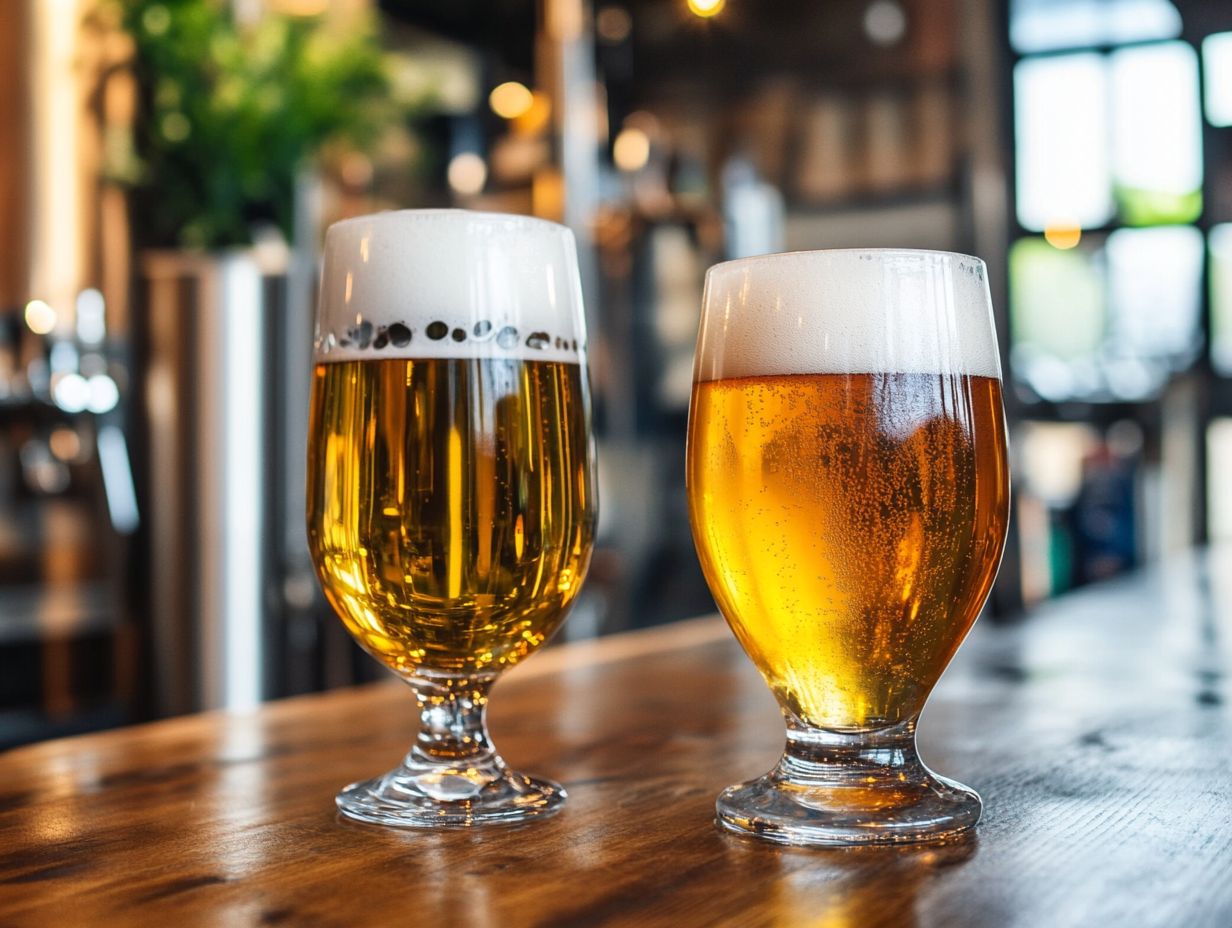
Preventing hazy beer in the future requires implementing best practices throughout the brewing process. This includes:
- Selecting the right ingredients
- Managing fermentation effectively
- Promoting optimal beer clarity
By focusing on proper yeast handling and using yeast nutrients, employing effective clarification methods such as Irish moss or Whirlfloc, and paying meticulous attention to sanitation, you can significantly reduce the risk of haze formation.
Regularly reviewing and refining your brewing techniques is essential for maintaining high standards of clarity. Continuous quality control allows you to identify potential issues early in the brewing timeline. Emphasizing the importance of consistent communication within your brewing team is also crucial. Understanding brewing science can greatly enhance this process.
By conducting routine analyses of water profiles, hop varieties, and other key ingredients like Wyeast and White Labs yeast, you can ensure that each batch meets specific clarity targets. Utilizing advanced filtration systems can further elevate the clarity of the final product by removing polyphenols and proteins that contribute to haze.
Ultimately, adopting a proactive approach to every step in the brewing process will help guarantee that every pint you serve is not only clear but also visually appealing. Whether you’re brewing a New England IPA, a hefeweizen, or a Witbier, clarity can significantly impact the visual appeal of the beer. Try these methods in your next brew and see the results for yourself!
Frequently Asked Questions
What causes hazy beer, such as chill haze or starch haze?
Several factors can contribute to hazy beer, including the use of unfiltered ingredients, improper handling during brewing, and the presence of yeast or other particles in the final product. High levels of polyphenols and proteins can also result in haze.
How does unfiltered beer, such as Belgian-style or Allagash White, contribute to haziness?
Unfiltered beer, such as Allagash White or some Belgian-style beers, contains sediment and particles that have not been removed during the brewing process. These particles can contribute to the haze and cloudiness of the beer.
Why is proper handling important in preventing hazy beer?
During the brewing process, handling the beer carefully is crucial to avoid agitation and the introduction of excess oxygen. These factors can lead to a hazy appearance in the final product.
What role do yeast and other particles play in cloudy beer, such as in a hefeweizen?
Yeast and other particles can remain in the beer after fermentation and contribute to the haze. This is especially common in unfiltered or bottle-conditioned beers, like a hefeweizen.
Can hazy beer, like Labatt Hazed and Confused or Dazed and Confused, be a sign of spoilage or contamination?
In most cases, haziness in beer does not indicate spoilage or contamination. If you notice a haze with strange flavors or smells, it could indicate a problem with quality.
How can I address hazy beer in my brewing process and avoid issues like oxidation haze?
To prevent hazy beer, use properly filtered ingredients and handle the beer carefully throughout the brewing process. Properly chilling and storing the finished product is essential.
Using fining agents like Irish moss or Whirlfloc (substances that help clear beer) and performing a cold crash (rapidly chilling the beer) can help clarify your brew. Also, minimizing oxygen exposure is crucial to avoid oxidation haze.

